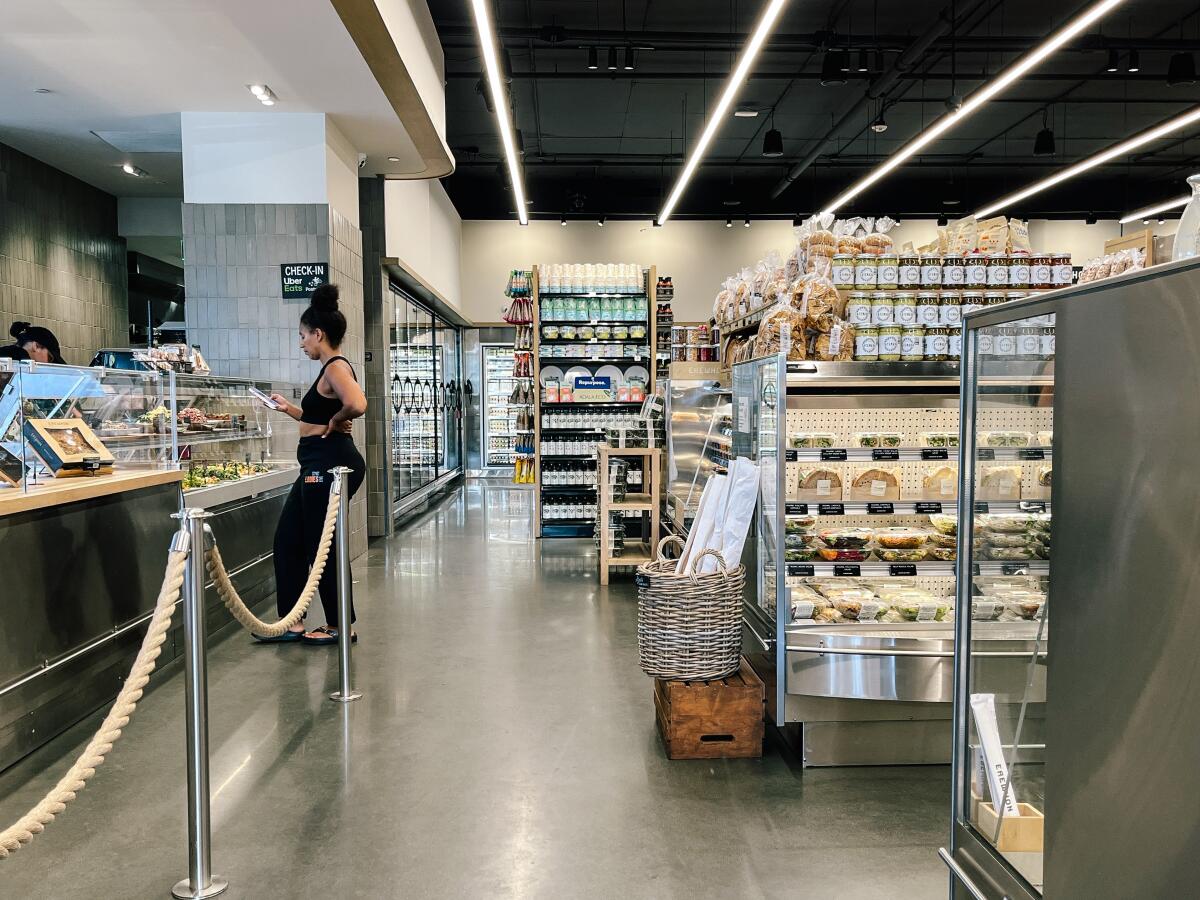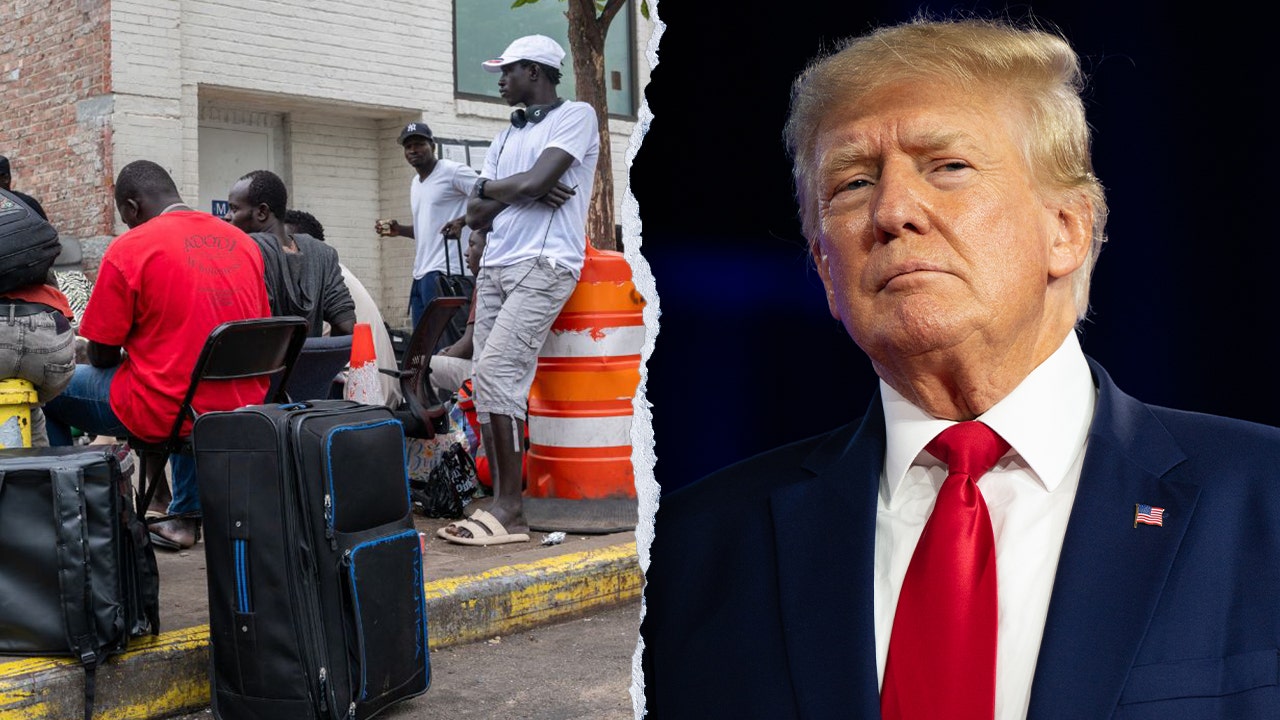Business
Column: Meet the architect of Trump's attack on birthright citizenship, a California lawyer facing disbarment

Donald Trump’s flurry of first-day executive orders aimed at remaking American government in his image may have Americans’ heads spinning, but one stands out from the rest for its sheer audacity.
That’s the order to rescind “birthright citizenship,” which is constitutionally granted to almost all children born within the U.S. borders.
Opposition to birthright citizenship emerged almost immediately with its enactment as part of the 14th Amendment, which was adopted in 1868, and has waxed and waned in parallel with political controversies over immigration.
All persons born or naturalized in the United States, and subject to the jurisdiction thereof, are citizens of the United States.
— U.S. Constitution, 14th Amendment
But its emergence as a core issue for Trump owes much to the work of a California lawyer. He’s John C. Eastman, a longtime Trump advisor who is facing disbarment proceedings due to his role in the Jan. 6 insurrection.
Eastman has advocated a reconsideration of birthright citizenship — or as I wrote in 2020, “flogging this dead horse” — for years. He has consistently been in the minority among legal authorities on the topic.
Still, he maintains, as he did in a recent conversation with me, that “the leading scholars on this issue all agree with me.”
He added: “I’ve probably been most prominent more recently in articulating that position.” He declined to say if he had consulted with the Trump campaign or transition team before Trump issued the executive order.
Eastman’s criticism of birthright citizenship unfurled mostly through legal treatises and in conservative publications until 2020, when an article he wrote for Newsweek made him the public face of the issue.
The article, which appeared the day after Joe Biden picked Kamala Harris as his 2020 running mate, questioned whether Harris was eligible for the office of president (or by extension vice president) because she didn’t meet the constitutional requirement that a president be a “natural born citizen.”
“Her father was (and is) a Jamaican national, her mother was from India, and neither was a naturalized U.S. citizen at the time of Harris’ birth in 1964,” Eastman wrote. “That … makes her not a ‘natural born citizen.’”
Within days, Eastman’s argument was taken up by Trump, who cited him as a “very highly qualified and very talented lawyer.”
Newsweek, however, promptly disavowed Eastman’s article. In an editor’s note, the magazine tried to rebut objections that it had been tied in with the “birther” claims that Barack Obama had not been born in the U.S. Rather, it said, the article was merely airing a legitimate legal debate. Two days later, it posted a second note, in which it stated that “this op-ed is being used by some as a tool to perpetuate racism and xenophobia. We apologize. … We entirely failed to anticipate the ways in which the essay would be interpreted, distorted and weaponized.”
Before examining the persistence of attacks on birthright citizenship, a few words about Eastman. The former dean and law professor at the Fowler School of Law of Orange County-based Chapman University has seen his activities as a lawyer for Trump lead his career down a dark hole.
Eastman played an important role in promoting Trump’s false claim that the 2020 election was stolen from him, and addressed the crowd at Trump’s Washington rally on Jan. 6, 2021, that led to the attack on the Capitol that day.
A week after that rally, Eastman and Chapman reached an agreement under which he agreed to retire from the university, effective immediately.
In January 2023, the State Bar of California launched disbarment proceedings against Eastman, citing his efforts to promote Trump’s unfounded claim that the election was stolen. After a more than monthlong trial in the state bar court, in a March 27, 2024, ruling, Bar Judge Yvette Roland found Eastman culpable on 10 of the 11 state bar charges and recommended his disbarment.
Eastman “made multiple false and misleading statements in his professional capacity as attorney for President Trump in court filings and other written statements,” Roland ruled.
Under state bar rules, as long as Roland’s disbarment recommendation stands, Eastman is ineligible to practice law in California. His license was also suspended by the Washington, D.C., bar. He is also facing felony charges in Georgia and Arizona connected with the 2020 election; both cases, in which Eastman has pleaded not guilty, are pending. None of these cases involve the birthright issue.
Eastman is still fighting disbarment, based in part on his position that his actions on Trump’s behalf are protected by his 1st Amendment free-speech rights and that his claims about the election being stolen weren’t knowingly false. Oral arguments before the state bar court are scheduled for March 19. If the disbarment recommendation stands, the final decision will be made by the state Supreme Court.
That brings us back to the birthright issue. The 14th Amendment was enacted as a direct response to the Supreme Court’s egregious 1857 Dred Scott decision, which held that persons of African descent, such as enslaved people and formerly enslaved people, could not be considered citizens under the Constitution.
In its very first line, the amendment states forthrightly, “All persons born or naturalized in the United States, and subject to the jurisdiction thereof, are citizens of the United States.”
Legalistic debate over birthright tends to parse the clause “subject to the jurisdiction thereof.”
Most legal scholars — and courts that have considered the issue — accept the prevailing conclusion that it was meant to exclude chiefly children of foreign diplomats and ministers and those of occupying foreign armies, who remain under the jurisdiction of their own countries.
(Native American tribes were also excluded initially on the reasoning that the tribes claimed sovereign authority, but they were brought under the amendment’s protection in 1924.)
Some critics argue that the amendment could not have bestowed citizenship on the children of illegal immigrants because “illegal immigration” didn’t exist in 1868, as the U.S. then had no immigration restrictions.
That’s a dubious claim, constitutional scholar Garrett Epps has written. “‘Illegal aliens’ are ‘subject to the jurisdiction’ of both state and federal legal systems. They can be, and are every day, arrested, prosecuted and sentenced (even to death) in American courts,” and can be sued in civil courts.
What Trump could do about birthright citizenship is unclear. Repealing the 14th Amendment would require a new constitutional amendment, a lengthy and complicated process.
Some experts have said that Congress could act to redefine “jurisdiction,” but even a leading expert on the topic, Rogers M. Smith of the University of Pennsylvania, has acknowledged being in the “minority of scholars who think the Congress can act” to exclude undocumented immigrants’ children.
Trump might be hoping that the current Supreme Court majority, which has disdained its own precedents, would scrap this one — though whether it would discard a precedent that has stood for more than a century is an imponderable.
The Supreme Court’s support of a broad definition of birthright citizenship dates to 1898, in a ruling involving Wong Kim Ark, whose citizenship as the U.S.-born child of Chinese immigrants was challenged because his parents had had no right to become citizens themselves. The court rejected the challenge.
In a 1982 case, all nine justices accepted the view that undocumented immigrants, “even after their illegal entry” to the U.S., are covered by the 14th Amendment.
A remarkable feature of birthright citizenship is that the broadest definition is supported not only by progressives, but conservatives. Newsweek published a rebuttal to Eastman’s article in 2020 by conservative UCLA law professor Eugene Volokh. At the same time, the libertarian Cato Institute attacked Eastman’s claims head-on. And on Inauguration Day, Cato’s director of immigration studies, David J. Bier, issued a series of broadsides against Trump’s executive order, calling it a “blatantly unconstitutional… attack on American tradition, the rule of law, the Constitution, and indeed Americans themselves.”
In truth, the core issue of birthright citizenship isn’t constitutional. It’s political, and its politics are acrid in the extreme. The issue is inextricably bound up with racism and the notion of America as a beacon of white supremacy.
That has been the one constant in the opposition to birthright citizenship since the enactment of the 14th Amendment, legal scholar Rachel E. Rosenbloom has observed, noting that opposition is typically couched “in a highly racialized language of crisis and invasion.”
A proponent of a proposed 2009 California ballot initiative aimed at cutting off public benefits for undocumented immigrants, for example, asserted that “illegals and their children” were engaged in “invasion by birth canal.” (The measure didn’t make it onto the ballot.)
Trump has repeatedly employed the rhetoric of xenophobia and invasion to justify his attacks on immigrants. “They’re poisoning the blood of our country,” he said at a rally in 2023, referring to immigrants “from Africa, from Asia, all over the world. They’re pouring into our country.”
Opposition to birthright citizenship has tended to surge alongside concerns about immigration, especially when the latter has had a racist component. The Wong Kim Ark case was designed as a test of the Chinese Exclusion Act of 1882; the 1982 case arose as a challenge to a Texas law that denied funding for the K-12 education of undocumented immigrant children. (The Supreme Court struck down the law.)
Eastman told me in 2020 that he was troubled by what he called the “false charge” that he questioned birthright citizenship merely “because Kamala Harris is Black.” He said then that he had been studying and writing about so-called birthright citizenship for nearly 20 years “in all sorts of contexts,” not merely Black politicians.
Notwithstanding Eastman’s disavowal of racist intent, one can’t attribute the same innocence to Trump and his immigration policy team. In his Jan. 20 executive order on border security, he again invoked “the language of crisis and invasion” — “Over the last 4 years,” the order states, “the United States has endured a large-scale invasion at an unprecedented level.”
Truly, the ideological basis of the attack on birthright citizenship has barely changed in 127 years.

Business
DeepSeek Prompts a Reckoning Across Wall Street and Silicon Valley

Good morning on this action-packed Monday. Mark this week on your “History of Artificial Intelligence Timeline”: The creation of DeepSeek, the Chinese A.I. sensation that we told you about last week, is shaking the technology industry to its core.
The super-efficient, open-source software is raising questions about the valuations of tech giants, including the chip maker Nvidia, with their stocks getting crushed today. Has the entire industry been wildly overspending? It’s also raising profound questions about how China may have undercut America’s most critical economic advantage on A.I. by making its technology free. We have more on all of this below.
Plus: Wall Street should pay attention to comments President Trump made late Friday that have flown under the radar.
The DeepSeek effect
Markets are on edge on Monday, as global tech investors face a $1 trillion wipeout. The cause: anxiety that the emergence of powerful — and cheap — Chinese artificial intelligence software could upend the economics of A.I.
Nasdaq futures have plummeted nearly 4 percent. And shares in Nvidia, the chipmaker whose processors help train and run A.I. software, are down 11 percent in premarket trading. Those in Constellation Energy, a utility betting heavily on powering A.I. data centers, are down nearly 13 percent.
Meanwhile, tech executives and policymakers have been left to wonder how strong America’s lead in A.I. is.
DeepSeek is forcing a reckoning in Silicon Valley. The company’s models appear to rival those from OpenAI, Google and Meta, despite the U.S. government’s efforts to limit China’s access to leading-edge A.I. technology. And DeepSeek says it did all this with a fraction of the resources that American competitors use.
Over the weekend, DeepSeek shot to the top of Apple’s App Store charts, rivaling ChatGPT. And DeepSeek is drastically undercutting OpenAI on price.
That raises a number of questions:
-
Do leading A.I. companies like Google, Meta and the privately held OpenAI and Anthropic deserve their astronomical valuations?
-
Do companies need to spend hundreds of billions on vast data centers powered by hugely expensive chips from Nvidia and others? Consider that OpenAI and its partners have promised to spend at least $100 billion on their Stargate project, or that Microsoft said it will spend $80 billion, or Meta $65 billion.
-
Does America need the huge uptick in electricity generation that has fueled a run-up in utility stocks?
American tech companies are scrambling to respond. The Information reports that Meta has tasked several teams of engineers with closely examining DeepSeek to see how they can improve their company’s own Llama A.I. software.
Already, American A.I. providers are rushing to dissuade customers from switching to cheaper DeepSeek offerings. (One potential stumbling block for some is that DeepSeek, as a Chinese company, won’t answer questions on sensitive topics such as those involving China’s leader, Xi Jinping, though developers say that it’s easy to modify the software.)
Satya Nadella, Microsoft’s C.E.O., has a more positive take: More efficient and accessible A.I. might lead to a “Jevon’s paradox” moment: “As AI gets more efficient and accessible, we will see its use skyrocket, turning it into a commodity we just can’t get enough of,” he wrote on X.
What will policymakers do? President Trump and other Western leaders have been anxious to unveil steps to bolster their homegrown A.I. industries, both by helping them grow and imposing constraints on Chinese rivals. But DeepSeek suggests there are limits to that approach.
Expect tough questions from analysts this week, especially as four of the so-called Magnificent Seven tech giants, including Meta and Microsoft, report earnings this week.
HERE’S WHAT’S HAPPENING
Hearings for Trump cabinet picks and the Fed loom large this week. Senators are expected on Monday to approve Scott Bessent as Treasury secretary. On Wednesday, they will hold confirmation hearings for Howard Lutnick, President Trump’s choice for commerce secretary, and Robert F. Kennedy Jr., the candidate for health secretary. Also on Wednesday, it’s decision day for the Fed: Many on Wall Street expect the central bank, wary of inflation, will keep interest rates steady.
Bitcoin falls below $100,000 as the industry deals with a flood of memecoins. The sell-off coincides with the broad slump in tech stocks, and comes despite an executive order by Trump to bolster the sector. (Tokens tied to the president and the first lady, Melania Trump, have slumped sharply again, amid a wave of criticism.) Meanwhile, Brian Armstrong, the C.E.O. of Coinbase, who criticized regulations by the Biden administration, suggested that regulators should create a “block list” for new digital tokens as his company struggles to deal with the million new ones being created each week.
Trump says he’s making progress on a TikTok sale. The president said he was in talks with several potential buyers to take control of the video app as part of an arrangement with ByteDance, the platform’s Chinese owner, with a potential decision in the next 30 days.
Trump continues his attack on banks
President Trump’s jab at Brian Moynihan, Bank of America’s C.E.O., grabbed headlines at the World Economic Forum in Davos, Switzerland, when he accused the executive of “debanking” his conservative supporters.
What many haven’t noticed that Trump has kept up his attack since then.
When the president visited Los Angeles on Friday for a round table on the California wildfires, he doubled down on his criticism of Bank of America. “They’re not nice. Sounds very nice, ‘The Bank of America.’ They are not nice,” he told someone in attendance. But he didn’t stop there, adding, “We’re doing numbers on banks.”
Trump’s issues have expanded beyond debanking. The conversation in Los Angeles was about the profit margin that banks often capture by charging a significantly higher interest rate on loans to consumers than the banks pay to borrow from the Fed.
Might he try to force banks to lower interest rates? Or could he make good on a campaign promise of capping credit card interest rates? (It’s not clear if he has the authority to do so via executive order.)
Trump’s relationship with banks is complicated. Few on Wall Street and finance are in Trump’s inner circle, especially compared with tech moguls (some of whom are trying to disrupt banking). Howard Lutnick, Trump’s pick for commerce secretary, comes from the rough-and-tumble brokerage business than the polished worlds of investment banking and commercial lending.
By contrast, Jamie Dimon of JPMorgan Chase has a more nuanced relationship with the president. Though he privately supported Kamala Harris in the 2024 election, the JPMorgan chief has said that Trump wasn’t wrong on issues including taxes and immigration at last year’s Davos, and this year said he’d be on board with tariffs if they’re good for national security.
Also worth noting: One of Bank of America’s largest shareholders is Warren Buffett, who has clashed with Trump in the past. That said, Buffett didn’t weigh in on the election and has been selling down his Bank of America stake since before November.
Trump is taking shots at banks just as they were expecting a friendlier administration., The industry, whose members had been prevented from merging for years, was expecting a wave of consolidation under Trump.
But there have already been signs that banking won’t get what it wants. Trump’s pick for Treasury secretary, Scott Bessent, said in his confirmation hearing this month that the five largest banks had too much market share.
What to read into Trump’s Colombia showdown
President Trump’s standoff with Colombia over immigration lasted just a few hours and played out mostly on social media.
But the fallout will likely reverberate among global leaders.
The latest: President Gustavo Petro of Colombia backed down from his refusal to accept American military planes carrying deportees into the South American country. His decision came after Trump threatened sanctions and tariffs — starting at 25 percent, and then climbing — on the country’s exports, including crude oil, coffee and cut flowers.
Petro’s U-turn gives the White House a victory on multiple fronts. Trump can show he’s living up to his campaign promise to crack down on illegal immigration.
And he can put other foreign capitals on notice that he will use tariffs to extract conditions that go beyond trade. “Today’s events make clear to the world that America is respected again,” the White House declared in a statement.
Allies won’t be spared. Colombia has long had close diplomatic ties to the United States — as do other targets of potential tariffs, Canada and Mexico. Some Trump aides want to proceed with tariffs on the latter on Feb. 1, talks or no talks, The Wall Street Journal reports.
Last week, the S&P 500 rallied in part on hopes that Trump’s recent tariff comments, especially about China, signaled a softer policy approach. Was that all a mirage?
And then there’s Greenland. Trump has coveted the autonomous Danish island for its strategic location in Arctic shipping and defense and for its mineral wealth, and has suggested he’d be willing to use military force or economic coercion to annex it.
On Air Force One this weekend, Trump told reporters that he could wrest control of Greenland from Denmark. “I think we’re going to have it. I think the people want to be with us,” he said, referring to Greenlanders.
Trump’s comments add to heightened tensions between Washington and NATO allies. “The Danes are saying, ‘Keep it down,’ but they’re scared,” Zaki Laïdi, an adviser to the former E.U. foreign policy chief Josep Borrell Fontelles, told The Times.
Douglas Emhoff’s next gig
The latest guessing game on the Washington-to-New York Acela is where former Vice President Kamala Harris and her husband, Douglas Emhoff, might go next. We know the answer to half of that question.
Emhoff will become a partner at the corporate law firm Willkie Farr & Gallagher, splitting his time between Los Angeles and Manhattan. He starts on Monday, advising companies on crises including litigation and corporate investigations, DealBook’s Lauren Hirsch is first to report.
Emhoff spent decades as a corporate lawyer before moving to Washington. He co-founded a boutique law firm in 2000, which he sold to a rival, Venable, in 2006. He left Venable in 2017 for DLA Piper, and stepped away full-time in 2020, partly to avoid conflicts of interest entanglements once his wife became vice president.
His clients have included Spotify and Lionsgate. He’s also represented Willie Gault, the former Olympic sprinter and N.F.L. star, whom he represented in an S.E.C. fraud case.
Willkie will tap Emhoff’s experience from his legal career and the White House. The second gentleman has amassed a network of key figures in entertainment, private equity and the corporate world.
Emhoff was a visible presence during the presidential campaign, helping his wife raise more than $1 billion. He also represented the U.S. in a diplomatic capacity at events like the 2024 Olympics in Paris, and led the Biden administration’s efforts to combat antisemitism.
“That got him in touch with very important leaders across the globe,” Thomas Cerabino, a co-chairman at Willkie, told DealBook.
THE SPEED READ
Deals
Politics and policy
Best of the rest
We’d like your feedback! Please email thoughts and suggestions to dealbook@nytimes.com.
Business
'Erewhon 2.0' is coming with three new locations opening in 2025

Erewhon, the luxury supermarket chain that turned grocery shopping into a hyper-trendy Los Angeles lifestyle, is ramping up its pace of expansion.
The company will move into three cities in 2025: Manhattan Beach, West Hollywood and Glendale.
It’s the most store openings in a single year since owners Tony and Josephine Antoci bought Erewhon in 2011, a sign of the organic grocer’s soaring popularity. And after relocating its central kitchen to a much larger industrial space last month, the company says it has the capacity to grow even more around Southern California.
“We see 2025 as the beginning of Erewhon 2.0 — a wave of expansion for us,” said Tony Antoci, who is chief executive.
In Glendale, Erewhon will be taking over the property previously occupied by Virgil’s Hardware Home Center.
(Gina Ferazzi / Los Angeles Times)
The Manhattan Beach store will be Erewhon’s first in the South Bay and is scheduled to open in March in a former Mother’s Market & Kitchen at 1700 Rosecrans Ave. After that, the West Hollywood store is set to open over the summer at 8550 Santa Monica Blvd. in a space that was previously a Sprouts. The Glendale store is expected to open toward the end of the year at the site of the old Virgil’s Hardware Home Center at 520 N. Glendale Ave.
Erewhon currently operates 10 markets, all of them in affluent areas of Los Angeles County. Its Pacific Palisades store, which survived the Palisades fire, is temporarily closed.
To support the addition of three new locations — and particularly the in-store cafes that have become core to Erewhon’s business — the company recently completed a three-year buildout of a new central kitchen in Vernon, which at 65,000 square feet is five times larger than its previous one in Boyle Heights.
Known as the commissary, the kitchen is where all of Erewhon’s TikTok-famous hot bar and tonic bar menu items — buffalo cauliflower, coconut chicken tenders, kale salads and gluten-free coconut chaga brownies — are prepped before being delivered to its grocery stores around 5 a.m. daily.
Unlike at traditional supermarket chains, Erewhon has cultivated a following of shoppers who visit daily to grab a prepared meal or one of its celebrity-backed $20 smoothies. The privately held company declined to share financial figures, but said its all-day cafes take up roughly 30% of floor space and serve 100,000 customers every week.
In a 2021 interview with The Times, Tony Antoci said about 40% of the company’s revenue came from its prepared foods and private-label products. Erewhon reportedly pulls in $1,800 to $2,500 in sales per square foot; the industry average is $500 per square foot.

A customer orders from the cafe at Erewhon in Culver City in July.
(Dania Maxwell / Los Angeles Times)
As Erewhon has increased its footprint around L.A. County, it has expanded and relocated its commissary every few years to keep up.
Roughly 350 of Erewhon’s 2,500 employees work out of the new 110,000-square-foot Vernon building. The commissary takes up more than half of the leased space and includes a bakery, juice room, pasta room, dry storage and production areas, a research and development kitchen and a training kitchen for the stores’ culinary managers. The rest of the building is being used as office space.
“It’s raising the ceiling of what we can accomplish,” said Tony, who called the commissary the “engine” of the business. “That means more variety, more consistency and more innovation.”

Erewhon’s new commissary, where all the food for its cafes is prepped, takes up 65,000 square feet in Vernon and includes a bakery, juice room, pasta room and dry storage warehouse.
(Andrew Kenney)
Erewhon didn’t start out as a premium grocer. It was founded in 1966 by Japanese immigrants Michio and Aveline Kushi, pioneers of the natural-foods macrobiotic movement who began selling imported organic goods such as brown rice, miso, soy sauce and umeboshi out of their Boston home. After the health department shut it down, the couple rented a small storefront nearby and named it Erewhon, an anagram of “nowhere.”
Erewhon grew to three stores and a distribution facility on the East Coast, and in 1969, the company opened a location in L.A. on Beverly Boulevard. The stores changed owners several times, and eventually the East Coast side of the business was folded into another grocery chain after a period of financial and management struggles.
When the Antocis bought the company for an undisclosed price 14 years ago, only one store remained and its cafe offerings were cooked on site, which limited the couple’s ability to open new locations.
The Antocis have embraced L.A.’s culture and used it to build a cultlike devotion among A-list stars and social media influencers, who have propelled many of its products into viral sensations.

Erewhon now has 10 organic grocers around Los Angeles County and a devoted fan base of well-off, wellness-minded customers.
(Dania Maxwell / Los Angeles Times)
To build upon the buzz, Erewhon has branched out beyond selling groceries.
Its fast-growing private-label line now includes Erewhon-branded apparel, bags, candles, nutritional supplements as well as bath and body products.
And its membership program has grown to roughly 50,000 people who pay $100 to $200 annually for special pricing, perks such as free drinks and access to its “lifestyle collective,” an array of discounts from resorts, workout studios, spas and athleisure brands.

Erewhon owners Tony and Josephine Antoci at the Studio City store in 2021.
(Genaro Molina / Los Angeles Times)
The company recently expanded its shipping range for nonperishable items, such as a jar of sea moss gel for $88 or a logo hoodie for $185, to a total of 19 countries.
But fans from around the U.S. continue to push for physical stores in other regions, which Tony Antoci said is “a major focal point for us.”
A store in New York, he added, is “absolutely on our radar.” In order to do so, the company would first need to build an East Coast commissary similar to the one in Vernon, he said.
“For the immediate future, we’re focusing on Southern California.”
Business
As Trump’s Immigration Crackdown Looms, Restaurants’ Undocumented Workers Fear the Worst

As the Trump administration rolls out its changes to the immigration system, fear is surging in the food-service industry as it braces itself for a promised crackdown on unauthorized workers.
Immigrant labor, both authorized and unauthorized, is integral to the staffing and running of restaurants in the United States. In a 2024 data brief, the National Restaurant Association reported that 21 percent of restaurant workers in the United States were immigrants. That figure does not include unauthorized workers, however; the Center for Migration Studies has estimated they number an additional one million employees.
Under the new administration, proprietors and workers are preparing for the worst.
An Immigration and Customs Enforcement sweep at the Ocean Seafood Depot in Newark on Thursday deepened the anxiety (though it is unclear whether the action, which resulted in three arrests, was part of the Trump administration’s plan). And many restaurant owners around the country were reluctant to be interviewed, saying they worried that their businesses and workers would be targeted. Several declined to comment at all.
Chicago and its restaurant industry have been anticipating actions by ICE since plans for post-inauguration immigration actions were leaked to the news media last week, with Chicago slated to be the first location.
Even well-known Chicago chefs and restaurateurs who have been vocal about political issues in the past, including immigration, were hesitant to speak publicly about the threat of immigration arrests, so as not to put “a target” on their businesses and employees as numerous owners told The New York Times.
A photo provided to The Times shows a handwritten sign in the kitchen of a prominent Chicago restaurant that reads: “Don’t let ICE in the building! And no snitching!” (The person who provided the photo asked that the restaurant not be named for fear of it being targeted.) And scripts have been passed around to employees at the restaurant, with recommended phrases to use in the event that they’re confronted by ICE agents.
One veteran Chicago chef and restaurateur, who asked not to be named for fear that his restaurant would be targeted by ICE, said that since Monday he had been keeping a binder at the host’s stand that advises employees what to do in case of an ICE visit.
The chef said employees who speak openly about the fear of ICE are those he knows stand no risk of actually being deported. “If you are one of the people who is legitimately worried about your immigration status,” he said, “you are going to be pretty quiet about it where you work.”
Andres Reyes said the threat of an immigration crackdown has been a topic of conversation among employees and customers at both locations of his Chicago restaurant, Birrierias Ocotlan. His father, Ramon, opened the original restaurant in 1973 in South Chicago, one of the city’s oldest Mexican immigrant neighborhoods.
“We have people who have been here for 40 years who are still working on getting their papers — and they are not criminals,” he said, referring to community members, not his employees. “They are working and they are contributing members of society. It’s unfortunate that they could be caught in the middle.”
According to the Migration Policy Institute, 53 percent of the unauthorized immigrants in Illinois have lived in the United States for more than 15 years, and 37 percent have at least one child who is a U.S. citizen.
Mr. Reyes attributed reduced business and slower-than-normal street traffic in the neighborhood in part to fear of the sweeps. “A lot of the unauthorized immigrants are now not spending money, because they are afraid of deportation or a setback,” he said.
Another of Chicago’s well-known Mexican American chefs, who requested anonymity, said misinformation was making an already stressful situation worse. The chef’s restaurant went on high alert on three occasions recently, after employees got word that nearby restaurants were being raided by immigration agents — only to learn that the rumors were false.
In Los Angeles, where longstanding fears of immigration enforcement had subsided in recent years, anxieties were running high among food-service professionals.
California is the state with the largest number of unauthorized immigrants — 1.8 million, according to the Pew Research Center. The Migration Policy Institute estimates that 950,000 of those people live in Los Angeles County. (More than half of those have lived in the United States for more than 15 years, and 17 percent are homeowners.)
One Los Angeles chef and restaurant owner, a U.S. citizen who grew up in Mexico, was preparing Friday for a meeting to address the fear of ICE visits with his entire staff and go over their plan, which included instructions on where to safely shelter in the building. ICE agents can legally visit public-facing areas of a business, like a dining room, but need either a warrant or permission from the staff to enter private spaces.
“Tensions are high, and this is something we should prepare for, like any emergency,” said the chef, who spoke on the condition of anonymity. “We should have a plan in place.”
A chef in San Francisco, who requested anonymity, said he hoped preparation would temper the angst among restaurant workers.
The chef, an unauthorized immigrant himself, was fielding questions from a jumpy staff. “When you’re scared, you’re scared of anyone in a uniform,” he said. “You see cops and wonder if they’re going to come inside — you don’t know what kind of power they have.”
He handed all of his employees fliers and cards made by an immigration lawyer with basic information about their rights. The chef plans to attend a seminar next week with local restaurateurs and lawyers to gather more information and legal advice.
He also had a conversation with his family about what to do if he were detained — whom to call first and where to go. “All we can do right now is get prepared, instead of feeling scared, which is easier said than done.”
In Washington, D.C., Erik Bruner-Yang, the chef and owner of Maketto, is awaiting guidance from the Restaurant Association Metropolitan Washington.
“I think right now everyone’s waiting to see what’s really going to happen with immigration,” he said. “R.A.M.W. has been really good about providing resources, and they were during the first Trump administration. To be fair, the Obama and the Biden administration weren’t that great, either, when it came to deportations.”
Téa Ivanovic, a founder and the chief operating officer of Immigrant Food, which has a location a block from the White House, said the unintended consequences of mass deportations could extend far beyond the fate of individual workers.
“I think as any business owner, especially in the food industry, where we’re completely dependent on immigrant labor and it’s a trillion-dollar industry,” she said. “I think it’s very concerning when they’re talking about workplace raids.”
Follow New York Times Cooking on Instagram, Facebook, YouTube, TikTok and Pinterest. Get regular updates from New York Times Cooking, with recipe suggestions, cooking tips and shopping advice.
-
/cdn.vox-cdn.com/uploads/chorus_asset/file/25835602/Switch_DonkeyKongCountryReturnsHD_scrn_19.png)
/cdn.vox-cdn.com/uploads/chorus_asset/file/25835602/Switch_DonkeyKongCountryReturnsHD_scrn_19.png) Technology1 week ago
Technology1 week agoNintendo omits original Donkey Kong Country Returns team from the remaster’s credits
-

 Culture1 week ago
Culture1 week agoAmerican men can’t win Olympic cross-country skiing medals — or can they?
-

 Culture7 days ago
Culture7 days agoBook Review: ‘Somewhere Toward Freedom,’ by Bennett Parten
-

 World1 week ago
World1 week agoChrystia Freeland, Justin Trudeau’s ‘Minister of Everything,’ Enters Race to Replace Him
-

 Education1 week ago
Education1 week agoReport Projecting Drop in Freshman Enrollment Delivered Incorrect Findings
-

 News1 week ago
News1 week agoCNN liable for defamation over story on Afghanistan 'black market' rescues
-

 World1 week ago
World1 week ago‘Fields were solitary’: Migration raids send chill across rural California
-

 World1 week ago
World1 week agoCommission claims slashing of foreign offices still under negotiation















